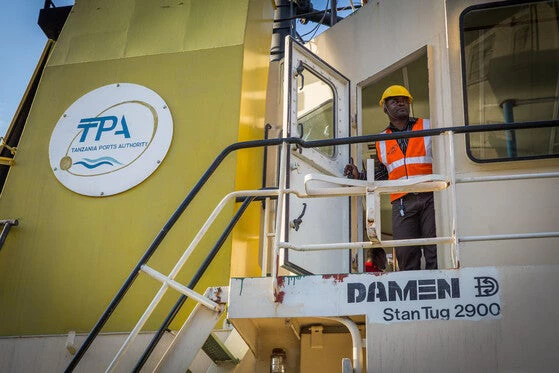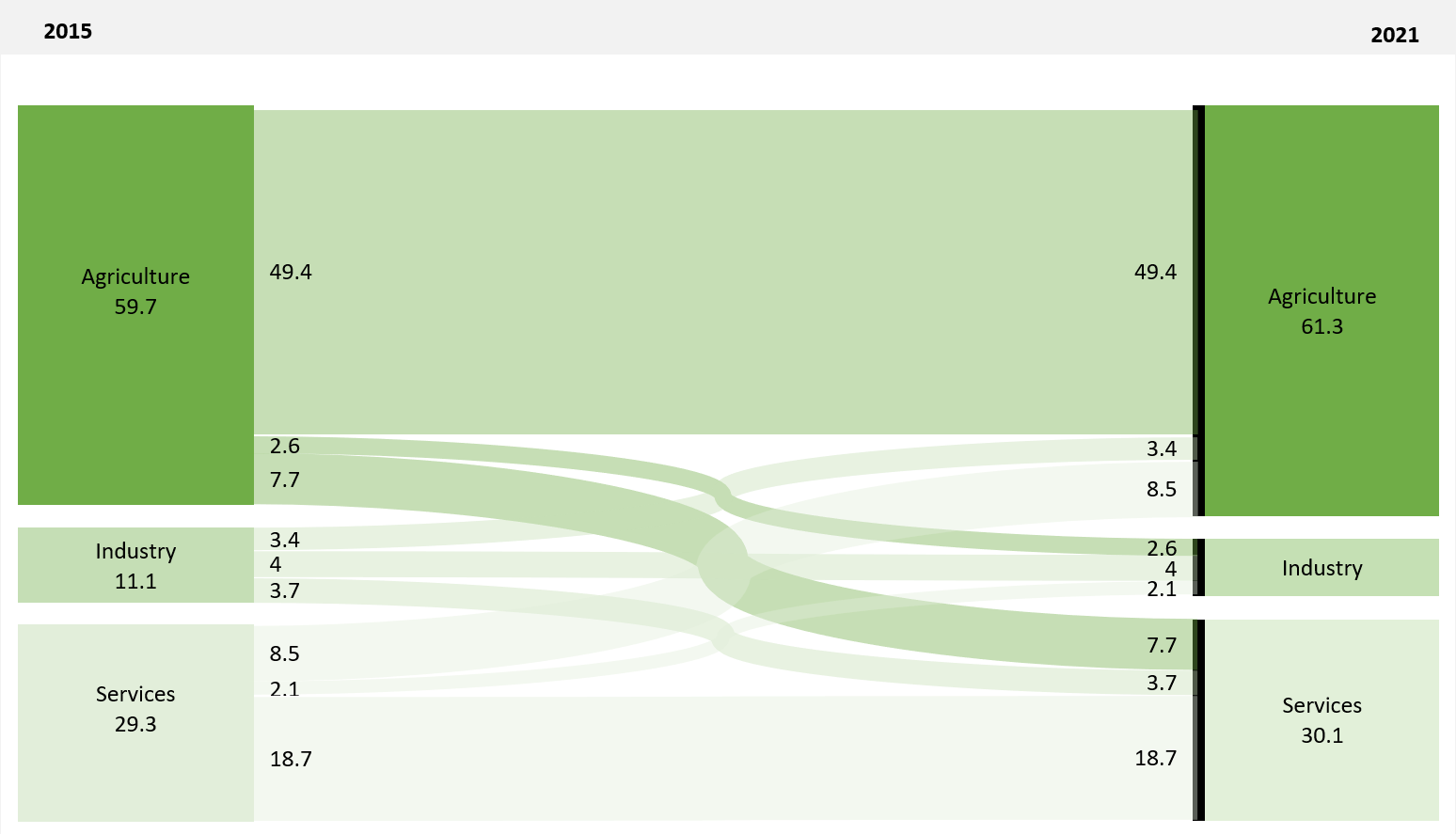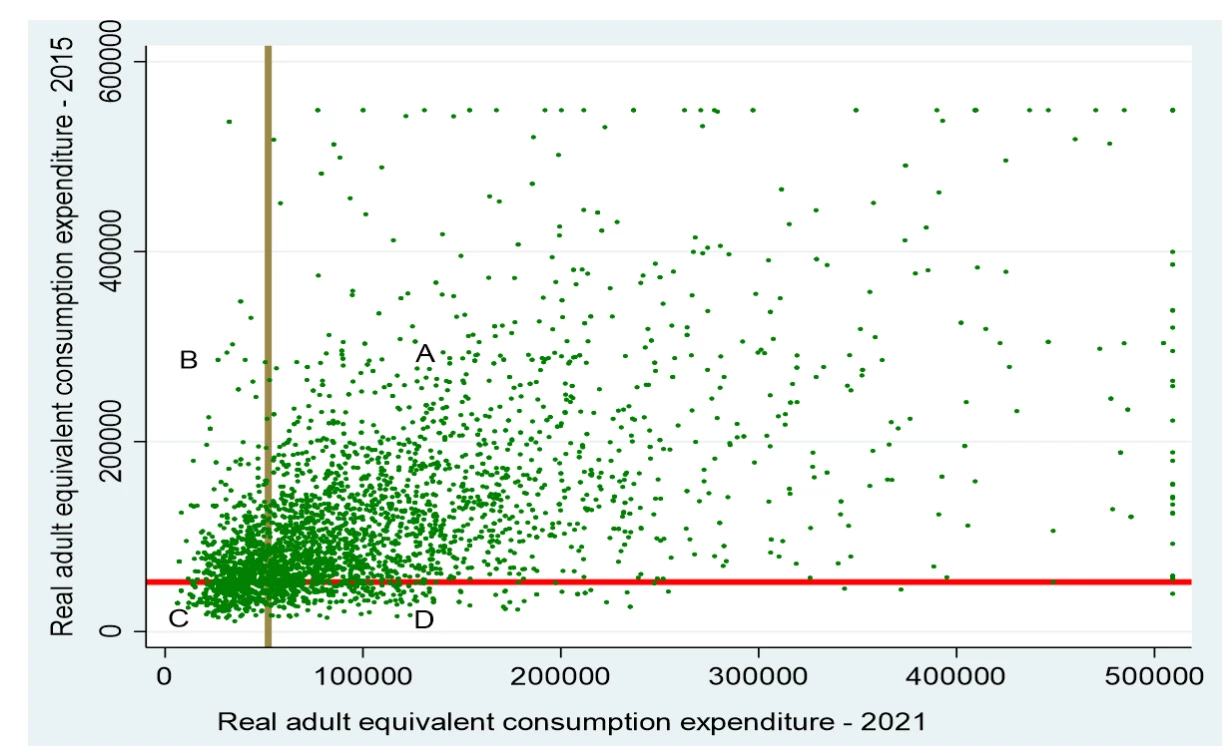Understanding whether poverty reduction can be accelerated by sectoral employment shifts—which are at the heart of structural change in low- and middle-income economies—is the focus of our new paper titled “The Welfare Effects of Structural Change and Internal Migration in Tanzania.”
This paper analyzed and leveraged the Tanzania National Panel Survey (NPS), a longitudinal household survey conducted in 2014-15 and 2020-21 by the National Bureau of Statistics with support from the World Bank’s Living Standards Measurement Study (LSMS). This research provided previously undocumented, micro-level insights on structural change in Tanzania—specifically the evidence on individuals’ transitions between sectors of employment (agriculture, industry, and services) and the links to internal migration patterns and welfare outcomes at the household level.
The analysis of cross-sector labor movements revealed the prominence of transitions occurring between the agriculture and services sectors (Figure 1). At the same time, a significant proportion of the individuals studied predominantly continue to engage in agriculture. On internal migration, the data shows that about 9 percent of individuals moved across districts in the 5 years preceding the 2020-21 National Panel Survey.
Figure 1: Transitions in Sector of Employment between 2015 and 2021 (percentages)
Note: Denominator is total of employed individuals in the sample.
Figure 2 shows an intriguing pattern of welfare transitions of the individuals studied. While most individuals in Tanzania were living in non-poor households in both 2015 and 2021 (quadrant A), the headcount poverty rate did increase between 2015 and 2021. Also, 2021 witnessed more individuals descending into poverty than those making strides towards prosperity (quadrants B versus D).
Figure 2: Mapping the Welfare Landscape: Visualizing Welfare Transitions 2015-2021
The two straight lines, each representing the international poverty line (US$2.15 2017 PPP which is the same in both periods), cross each other to yield the four welfare quadrants.
Furthermore, our regression analysis showed that changes in consumption expenditure, poverty headcount, and positive and negative poverty transitions are significantly influenced by individuals’ employment transitions. While a shift from agriculture to services is welfare-enhancing, the reverse transition affected welfare outcomes negatively.
However, a move from agriculture to industry would reduce the likelihood of escaping poverty. This suggests that the welfare effects of cross-sector labor movements between agriculture and industry may be more dependent on the specific activities or subsectors—such as crops, fisheries, or mining—within the broad sectors (agriculture, industry, and services) between which the movements occur. Moreover, we documented a positive association between internal migration and cross-sector labor movements, especially those that are welfare-enhancing. |
These results were generally consistent with the established trajectory of structural change in low- and middle-income countries, often different when compared to the ones of high-income nations.
Moreover, we found that both sectoral transitions and internal migration are driven by similar micro-factors, such as gender, age or geographic location. Also, we emphasized the importance of education (particularly secondary or higher education) in increasing the chances of an individual embarking on a welfare-enhancing sectoral movement and its associated migration across districts. The results also showed that younger individuals are more likely to migrate internally and move to welfare-enhancing sectors compared to their older counterparts. Thus, enhancing access to education among young people is critical for ensuring that structural change is transformative enough to improve welfare in Tanzania.
Finally, agriculture in Tanzania continues to be the main employment alternative for an individual to earn money after potentially losing their job in the services or industry sectors. This underscores the need for transformative agricultural policies aimed at boosting productivity levels within the sector to improve the well-being of individuals who continue to depend on agriculture.
Want to learn more? Here are some useful resources:
-
Download and read the full working paper "The Welfare Effects of Structural Change and Internal Migration in Tanzania"
-
Find out more about the Living Standards Measurement Study (LSMS)







Join the Conversation